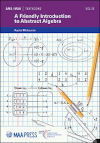- About MAA
- Membership
- MAA Publications
- Periodicals
- Blogs
- MAA Book Series
- MAA Press (an imprint of the AMS)
- MAA Notes
- MAA Reviews
- Mathematical Communication
- Information for Libraries
- Author Resources
- Advertise with MAA
- Meetings
- Competitions
- Programs
- Communities
- MAA Sections
- SIGMAA
- MAA Connect
- Students
- MAA Awards
- Awards Booklets
- Writing Awards
- Teaching Awards
- Service Awards
- Research Awards
- Lecture Awards
- Putnam Competition Individual and Team Winners
- D. E. Shaw Group AMC 8 Awards & Certificates
- Maryam Mirzakhani AMC 10 A Awards & Certificates
- Two Sigma AMC 10 B Awards & Certificates
- Jane Street AMC 12 A Awards & Certificates
- Akamai AMC 12 B Awards & Certificates
- High School Teachers
- News
You are here
A Friendly Introduction to Abstract Algebra

Buy Now:
Publisher:
AMS
Publication Date:
2022
Number of Pages:
387
Format:
Paperback
Price:
69.00
ISBN:
978-1-4704-6881-1
Category:
Textbook
[Reviewed by , on ]
Mark Hunacek
08/22/2022
This is a “groups first” textbook for the first course in undergraduate abstract algebra, pitched at a rather elementary level and assuming no prior exposure to proof-based mathematics. It begins with sections on proof techniques and sets, proceeds through elementary group theory (up to quotient groups and the isomorphism theorems), and then ends with ring theory (up to quotient rings, prime and maximal ideals, and fields of the form \( F[x]/(p(x)) \).) More sophisticated topics (Sylow theory, the fundamental theorem of abelian groups, finite fields, Galois theory) are not covered; neither are applications of abstract algebra.
The title promises a “friendly” introduction, and the author works hard to deliver on that promise. His writing style is conversational, examples abound (and are introduced before abstract ideas are defined), and there are frequent useful side remarks called “Proof know-how”, where suggestions for how to come up with a proof, including templates for constructing frequently occurring proofs (such as proving that a function is 1-1) are given.
So far, so good. Unfortunately, however, problems arise. One concerns the placement of material in the book. Example: chapter 15 is called “Functions” and covers domains, codomains, 1-1 and onto functions. Although this material is absolutely fundamental and is usually covered in the very beginning of the course, this chapter doesn’t start until page 147. The word “function” is, however, used previously (for example, page 51), without formal definition. It isn’t given a formal definition in chapter 15, either; the author just gives a simple example and from this refers to the “rule” of the function, the domain and the codomain. Examples are a great way to motivate a definition, but cannot serve as one. The example he gives, by the way, is the function from \( Z_{12} \) to \( Z_{18} \) that takes \( a \) into \( 6a \), and the necessity of showing that this is well-defined is never mentioned.
Another problem concerns the omission of some definitions and topics that should have been included. For example, the word “abelian” appears only once in the text; the author prefers “commutative”. I can live with that, but, much more disturbingly, equivalence relations are not, as far as I can see, mentioned at all in this book, an omission that I cannot justify. Sometimes, also, explanations are omitted: it is mentioned that the empty set is a subset of every set, but no reason at all for this is given. A student reading this may not even realize that a reason is necessary.
I also was bothered by what I thought was an occasional lack of rigor and precision, probably caused by the author’s attempt to make the book as “friendly” as possible. Let me illustrate with an extended example. Chapter 4 introduces the groups \( Z_{n} \). The author begins by discussing \( Z_{7} \), this discussion morphing (without explicit definition) to \( Z_{n} \) halfway through the chapter. This is another example of an example serving as a definition. But even the definition of \( Z_{7} \) is troubling. Because equivalence relations have not been defined, the author is forced to define \( Z_{7} \) as the set \( \left\{0, 1, 2, 3, 4, 5, 6 \right\} \), using the somewhat ill-defined idea that \( a = b \) in \( Z_{7} \) if and only if \( 7 \) divides \( b – a \). So, for example, the author states “\( 30 = 2 \) in \( Z_{7} \)”, a statement that might confuse students because 30 isn’t even in \( Z_{7} \).
Things get even worse in chapter 8, where the author discusses the group properties of \( Z_{n} \). Addition in \( Z_{7} \) (and presumably \( Z_{n} \) was defined using “clock arithmetic”, and the author’s “proof” in chapter 8 that this is associative (for \( n = 35 \)) reads, in its entirety: “After all, addition in \( Z_{35} \) is based on addition in \( Z \).” No student in any abstract algebra class should ever be led to believe that this is a proof. The fact is that if modular addition is defined correctly (and proved to be well-defined) then it really is easy to prove associativity, but if it is defined as “the remainder of the sum when divided by 35”, which is essentially how the author defines it, proving associativity is by no means easy and certainly the fact that it “based on” ordinary integer addition is not a sufficient argument.
Bottom line: an abstract algebra text should, of course, tell the students what groups, rings, and fields are, and give them lots of examples of these objects. But it should also teach them that careful and precise definitions and proofs are essential, even if they are hard.
Mark Hunacek (mhunacek@iastate.edu) is a Teaching Professor Emeritus at Iowa State University.
See the publisher's website.
- Log in to post comments




